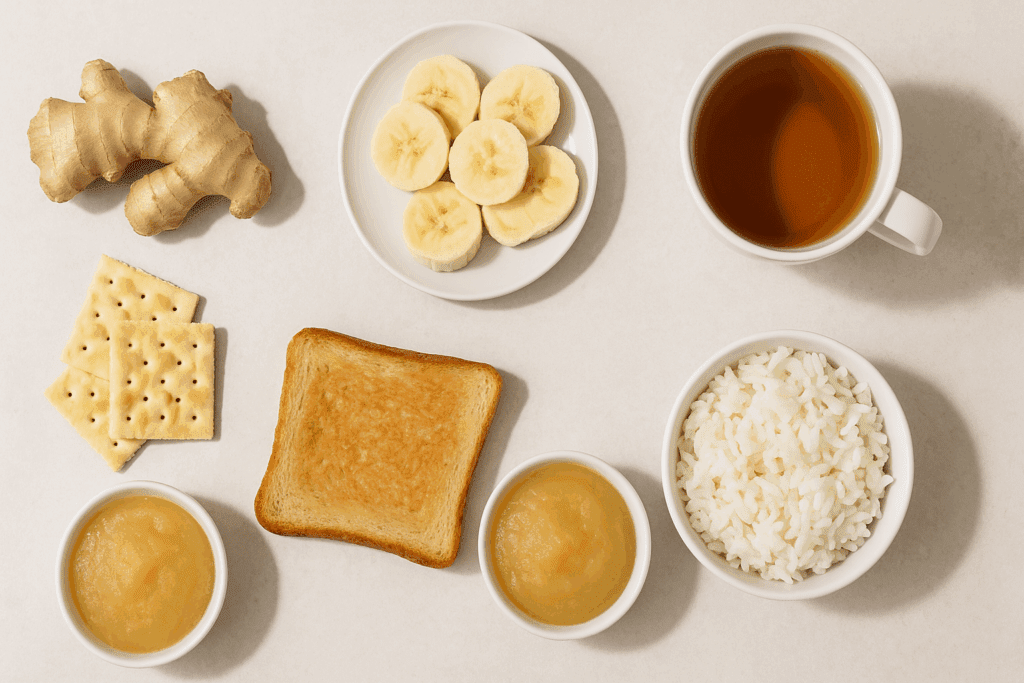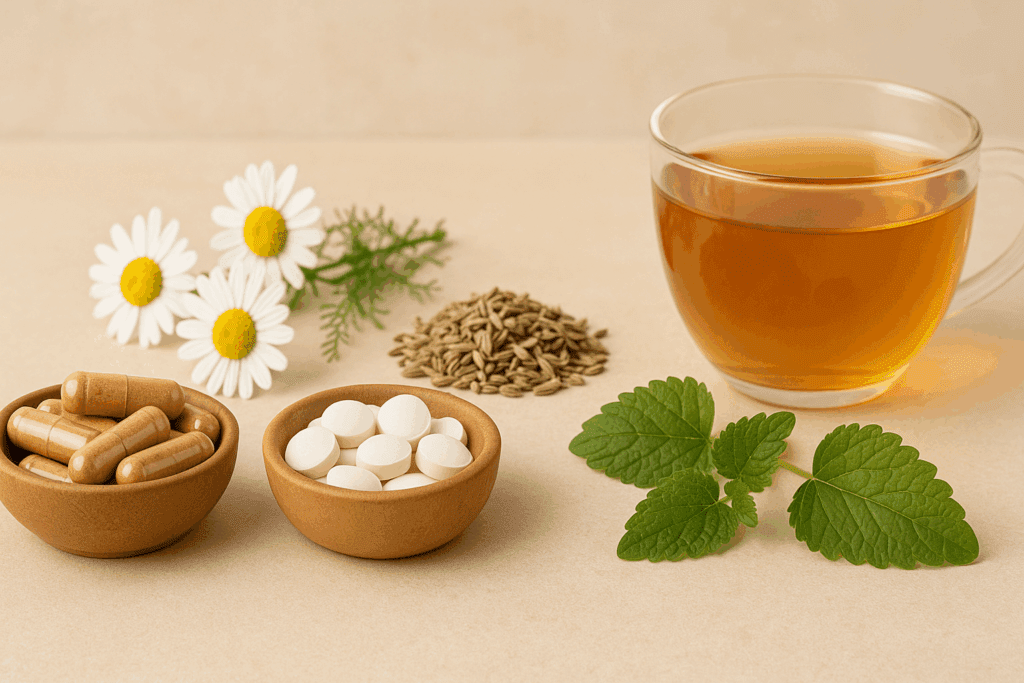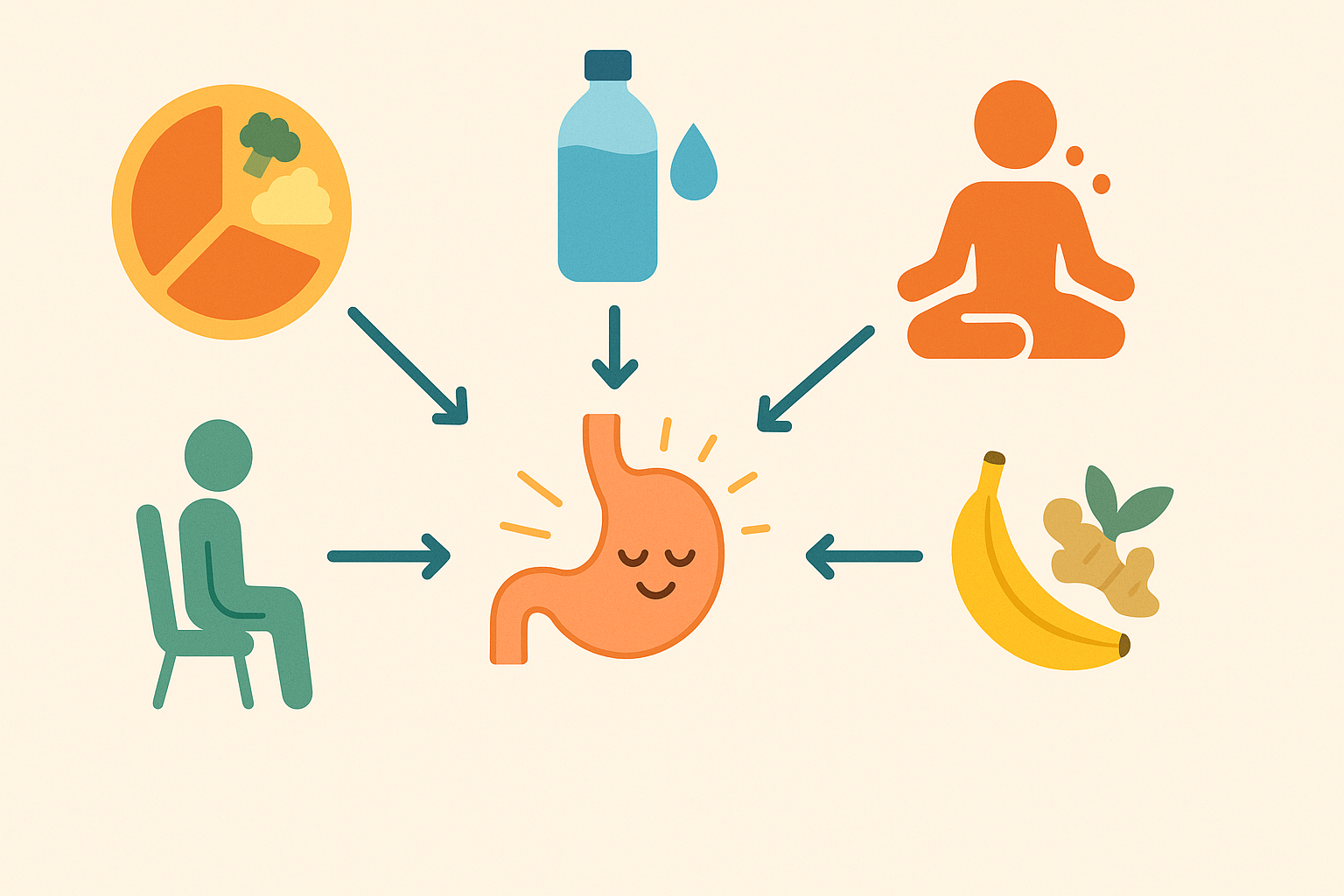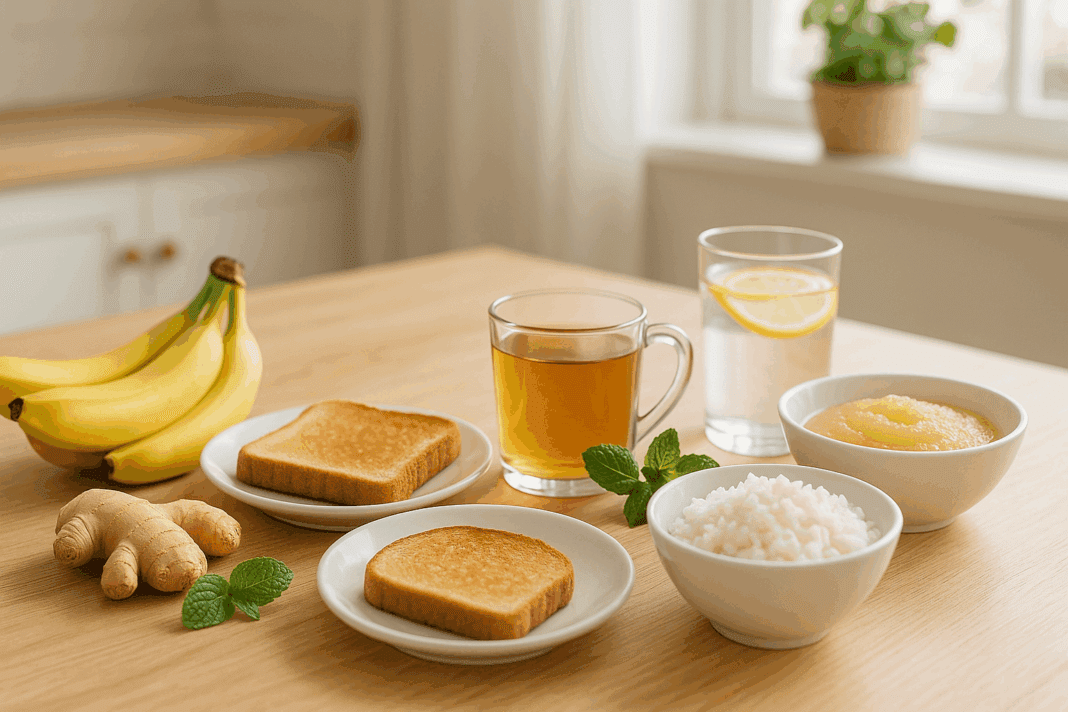Nausea can be an unwelcome and debilitating experience that disrupts daily life, diminishes appetite, and causes physical discomfort. Whether it’s triggered by illness, medication, pregnancy, or digestive issues, finding effective, evidence-based strategies to manage nausea is essential for both short-term relief and long-term well-being. Among the most accessible and natural interventions are foods that help with nausea. These foods, when chosen wisely, can soothe the stomach, ease queasiness, and support the recovery process without the harsh side effects associated with pharmaceutical interventions.
Understanding the causes of nausea is crucial to identifying the best dietary solutions. Often, nausea arises from gastrointestinal disturbances, infections, hormonal changes, motion sickness, or even psychological stress. Regardless of the cause, nutritional choices can play a vital role in how the body responds and recovers. This guide delves into the science behind nausea and explores a comprehensive selection of foods that not only relieve symptoms but also promote digestive health. Readers will also learn what to avoid when experiencing queasiness and how to build a sustainable plan for long-term gut support.
You may also like: The Ultimate Guide to Gut Healthy Meals: Best Meals for Gut Health and Nourishing Recipes You’ll Love

The Science of Nausea: Why We Feel Sick to Our Stomachs
Nausea is the uneasy sensation that often precedes vomiting, but it doesn’t always lead to it. It is a complex reflex controlled by the brain’s vomiting center, which receives input from various parts of the body, including the gastrointestinal tract, inner ear (balance), and higher brain centers involved in emotion and stress. Because nausea can be caused by such a wide range of stimuli, its treatment must often be multifaceted.
For instance, motion sickness stems from a mismatch between visual signals and signals from the inner ear. Gastroenteritis, on the other hand, irritates the stomach lining, directly triggering nausea. Medications, especially chemotherapy drugs, affect neurotransmitters in the brain, while pregnancy-induced nausea often results from hormonal fluctuations. In all of these scenarios, the digestive system becomes hypersensitive, and the body attempts to signal a need for rest or detoxification.
Recognizing the cause of nausea is the first step to finding the right dietary strategy. While anti-nausea medications are sometimes necessary, they are not always ideal for daily use due to potential side effects like drowsiness or constipation. This is why identifying foods that help ease nausea and adopting a gentle, gut-friendly diet can be a safer and more sustainable long-term approach.

Foods That Help with Nausea: Gentle Choices Backed by Science
Among the most recommended foods for nausea are those that are bland, low in fat, and easy to digest. Ginger, for instance, has long been celebrated for its antiemetic properties. Clinical studies have shown that ginger can help reduce nausea caused by pregnancy, chemotherapy, and motion sickness by acting on the gastrointestinal tract and central nervous system.
Bananas are another excellent choice. Not only are they soft and easy to digest, but they also replenish potassium—a critical electrolyte that may be depleted due to vomiting. Their natural sweetness and low acidity make them particularly tolerable during acute phases of nausea. The question “do bananas help with nausea?” is answered with a resounding yes by both scientific literature and anecdotal experience.
Plain rice, toast, and applesauce—often referred to as part of the BRAT diet (bananas, rice, applesauce, toast)—are classic recommendations for a reason. These foods help provide energy without irritating the stomach lining. They are ideal for those wondering what to eat after vomiting or how to not vomit again shortly after a meal. Crackers and dry toast can also settle the stomach by absorbing excess gastric acid, providing quick relief.
When considering foods that curb nausea, it is important to recognize that hydration also plays a critical role. Sipping on clear fluids such as electrolyte-rich broths or diluted fruit juices can keep the body hydrated and help ease nausea. Herbal teas, especially those made from peppermint or chamomile, have calming effects on the digestive system, aiding in the relief of queasiness.

What to Eat When Nauseous: Building a Gentle Recovery Meal Plan
Constructing meals during periods of nausea requires attentiveness and care. Start with small, frequent portions rather than large meals, as overfilling the stomach can worsen symptoms. Foods to eat when nauseous should be high in moisture, low in fat, and not heavily seasoned.
In the early stages, when the stomach is still sensitive, simple foods like plain boiled potatoes, oatmeal made with water, and mild soups can be tolerated well. As the appetite begins to return, incorporating foods that help ease nausea and simultaneously support nutrition—like smoothies with ginger, banana, and a hint of honey—can offer a gentle yet nutrient-rich option. These foods also answer the common concern about what is good for nausea that doesn’t compromise nutritional needs.
When considering what to eat if nauseous, temperature also matters. Cold or room-temperature foods are often more palatable than hot meals. They emit less aroma, which can sometimes trigger nausea, especially during pregnancy or illness. Frozen fruits, popsicles made from real fruit juice, or chilled cucumber slices are refreshing and help hydrate the body.
Throughout recovery, it is essential to listen to the body. Some days, the answer to what to eat while nauseous may be as simple as sipping broth. On other days, a small bowl of white rice with a banana on the side might provide both comfort and calories. This approach empowers individuals to tailor their intake according to their unique responses, gradually rebuilding strength and digestive stability.

Foods for Nausea: Integrating Holistic Supplements and Herbal Support
Incorporating holistic supplements alongside dietary choices can further enhance nausea relief. For instance, ginger supplements, available in capsules or chewable tablets, offer concentrated anti-nausea support without requiring one to consume large quantities of the root. These are particularly useful for travelers, chemotherapy patients, or pregnant individuals who find fresh ginger too pungent.
Vitamin B6, or pyridoxine, has been shown in multiple studies to reduce nausea in pregnancy when taken in appropriate doses. While it’s important to consult a healthcare provider before beginning any supplement regimen, B6 can be a powerful ally when dietary changes alone are insufficient. Probiotic supplements may also aid in restoring gut flora after illness or antibiotic use, thereby addressing one potential root cause of nausea.
Other herbal remedies with traditional use and emerging scientific support include fennel, licorice root, and lemon balm. These herbs have antispasmodic properties that calm the digestive tract, reduce bloating, and lessen the intensity of nausea. Teas or tinctures made from these herbs offer a natural way to address what can help with nausea without over-relying on pharmaceuticals.
It is essential to use these supplements wisely and under professional guidance. The holistic approach recognizes that gut health and systemic balance are intertwined, and restoring digestive harmony requires a nuanced, integrative plan that includes foods for nausea as well as safe, evidence-based supplemental support.
What to Avoid When You Feel Like Vomiting After Eating
Understanding what to avoid when feeling nauseous is as critical as knowing what to eat. Fatty, fried, or spicy foods tend to delay gastric emptying and stimulate acid production, both of which can worsen nausea. Similarly, caffeinated beverages can irritate the stomach and increase dehydration, making symptoms more difficult to manage.
Processed and overly sweetened foods—such as candies, pastries, and sodas—may provide a quick energy spike, but they often lead to subsequent crashes and can intensify queasiness. For those curious about what to do when you feel like vomiting after eating, avoiding strong-smelling or greasy foods is a sound first step.
Alcohol and carbonated beverages should also be approached with caution. Not only can these disrupt the gut microbiome, but they also contribute to gas and bloating, further exacerbating nausea. When in doubt, sticking with bland, whole foods that are minimally processed offers a safer, more gut-friendly route.
For those recovering from illness or post-surgical procedures, even seemingly healthy foods—like raw vegetables or high-fiber legumes—might need to be temporarily limited, as they can be hard to digest. Gradually reintroducing complex foods after nausea subsides ensures that the digestive system is not overwhelmed.
Navigating these dietary decisions may feel daunting, especially when the appetite is inconsistent or unpredictable. However, by recognizing the worst foods for nausea and staying informed about how to relieve nausea through thoughtful choices, individuals can regain control and foster long-term wellness.

Foods to Eat After Vomiting: Rebuilding with Care and Caution
The aftermath of vomiting leaves the stomach and digestive tract in a fragile state. It is essential to ease back into eating with foods that are not only soothing but also capable of replenishing lost nutrients. Hydration should be the first priority. Small sips of water, electrolyte solutions, or clear broths help rehydrate the body and prepare the gut to tolerate solid foods again.
When considering foods to eat after vomiting, the timing of reintroduction matters. Begin with very small amounts of bland foods. White rice, applesauce, and mashed bananas are ideal starters. These foods for nausea are easily digested and provide simple carbohydrates and minerals to restore energy levels. Avoid adding salt, butter, or dairy at this stage, as these can irritate the lining of the stomach.
Once these initial foods are tolerated, slightly more complex options such as oatmeal, plain boiled noodles, or soft-cooked carrots can be introduced. Again, preparation should be minimal—no added spices or sauces—to reduce the risk of recurrence. Including foods that decrease nausea helps prevent a return to discomfort and promotes a steady path toward full recovery.
Some individuals find that frozen treats like ice chips or electrolyte popsicles help reduce nausea while offering hydration and comfort. These options can be particularly helpful for children or those who are reluctant to eat. What to eat during vomiting episodes may not always involve solids but incorporating even small amounts of liquid nutrition can provide relief.
As with all stages of nausea management, patience is key. It can take time for the stomach to settle, and pushing food too soon may lead to setbacks. Listening to the body and offering it foods that help ease nausea rather than irritants is the most reliable path forward.
How to Stop Nausea Before It Starts: Preventive Nutrition and Lifestyle Habits
Preventing nausea requires a proactive mindset that blends dietary awareness with lifestyle habits. One important strategy is to eat smaller, more frequent meals rather than large, infrequent ones. This prevents the stomach from becoming overly full and reduces the likelihood of reflux or bloating, both of which can contribute to nausea.
Staying hydrated is equally important. Dehydration can both cause and worsen nausea, so maintaining a steady intake of water, herbal teas, and low-acid juices helps maintain balance. Avoiding long periods of fasting or skipping meals can also prevent the onset of nausea, particularly for those with sensitive stomachs or metabolic conditions.
Mindful eating practices, such as chewing food thoroughly, avoiding distractions during meals, and eating in a calm, upright posture, also reduce the burden on the digestive system. For individuals prone to motion sickness or migraines, avoiding trigger foods like chocolate, aged cheeses, or processed meats may be beneficial.
Integrating foods that help with nausea into everyday meals can act as a preventive measure. For example, including small amounts of ginger in cooking, drinking chamomile tea regularly, or choosing bland carbohydrates over heavily processed snacks contributes to a stable gut environment. What helps with nausea in the long term is not only what is consumed during an episode but the habits that shape one’s baseline digestive health.

What to Eat When Queasy: Personalizing Your Diet for Long-Term Gut Support
Queasiness can present in varying degrees and may require a personalized approach to dietary management. For some, simply lying down or sipping peppermint tea may suffice. For others, a more structured plan involving both nutrition and holistic care is necessary.
Listening to internal cues is essential. If the thought of a specific food makes one feel worse, even if it is generally considered one of the best foods for nausea, it should be avoided. Everyone’s gut responds differently, and tuning into these subtle signals is key to discovering what to eat while nauseous without risking symptom escalation.
Creating a journal of symptoms and food intake can be incredibly helpful in identifying patterns. If nausea consistently follows high-fat meals, switching to lower-fat alternatives may reduce frequency. Similarly, if certain smells or textures provoke nausea, these can be avoided while still meeting nutritional goals.
Over time, the body can be trained to tolerate a broader range of foods. Incorporating small amounts of fermented foods like yogurt or kefir can help repopulate the gut microbiota, reducing the likelihood of recurring nausea. This is especially beneficial after illness, antibiotic use, or stress-related digestive disruption.
Ultimately, managing nausea effectively requires more than a list of foods. It requires attention, intention, and a willingness to make adjustments based on the body’s feedback. By embracing a holistic strategy that includes foods that relieve nausea, supports gut health, and honors individual responses, lasting relief is not only possible but sustainable.
Frequently Asked Questions: Expert Insights on Foods That Help with Nausea
What makes certain foods more effective at curbing nausea than others?
Foods that curb nausea are typically effective because they either soothe the gastrointestinal lining, regulate digestive activity, or stabilize blood sugar levels, all of which can help reduce the feeling of queasiness. For example, complex carbohydrates like plain oatmeal can absorb excess stomach acid and are less likely to trigger reflux, while ginger can interact with serotonin receptors in the gut to help reduce nausea signals to the brain. Foods with minimal fat content are also easier to digest and less likely to delay gastric emptying, which is crucial when trying to learn how to stop nausea before it escalates. A lesser-known factor is the thermic effect of food—cool or room temperature items are often more tolerable than hot ones due to reduced aroma and stimulation of the vagus nerve. Understanding what helps with nausea from a biochemical standpoint allows for more intentional and effective dietary choices.
How do environmental and emotional factors influence which foods to eat when nauseous?
The foods to eat when nauseous often depend not just on the physical condition of the gut but also on emotional and sensory sensitivities. For instance, stress and anxiety can heighten gastric sensitivity, making even mildly spicy foods intolerable. Emotional triggers can also cause conditioned responses—if someone once vomited after eating a particular food, they may feel nauseated by its smell or texture even if it’s otherwise bland and safe. Light, neutral-colored meals like mashed potatoes or plain pasta can feel emotionally safer, which has real physiological benefits by reducing sympathetic nervous system activity. Additionally, quiet, low-stimulation environments while eating can enhance tolerance to food when nauseated, helping the body transition into a more relaxed, parasympathetic state. This interplay shows why individualized approaches are often more effective than generic recommendations for how to relieve nausea.
Why are some traditional remedies like ginger or mint more effective than over-the-counter options?
While pharmaceutical antiemetics work by targeting neurotransmitters like dopamine or serotonin, natural remedies such as ginger or peppermint can have multi-pathway benefits without the sedative side effects of drugs. For example, peppermint oil can relax smooth muscles in the gastrointestinal tract, reducing cramping and bloating, which often accompany nausea. In contrast, medications may suppress nausea without addressing underlying causes like gut dysbiosis or stress-induced spasms. Additionally, foods that help ease nausea, like those infused with peppermint or ginger, can be integrated into meals or drinks, offering a more holistic experience. For individuals exploring how to get rid of nausea through natural approaches, understanding the synergy between herbal compounds and gut-brain signaling can be especially empowering.
What are some advanced tips for choosing foods to eat after vomiting?
After vomiting, the digestive system enters a temporary phase of hypersensitivity. Choosing foods to eat after vomiting involves understanding both nutritional needs and mucosal healing. Beyond the usual BRAT diet, adding nutrient-dense but mild options like steamed pumpkin or bone broth can accelerate recovery. These foods provide minerals and amino acids that support tissue repair while still being gentle on the stomach. Coconut water is another excellent option, rich in electrolytes and easier to digest than commercial sports drinks. Knowing what to eat after vomiting also means paying attention to food texture—purees and soft foods are often more tolerable than solids. This attention to detail can make a substantial difference in how quickly one regains digestive stability.
How does nausea differ when it’s triggered by motion sickness, pregnancy, or illness—and how should dietary responses change?
Motion sickness-induced nausea stems from sensory mismatches and is often mitigated by dry, salty snacks like crackers that stabilize gastric activity without stimulating excess saliva production. Pregnancy-related nausea, especially during the first trimester, is hormonally driven and often responds well to cold foods that are low in odor and high in vitamin B6, such as avocados or fortified cereals. When nausea results from viral or bacterial illness, the gut is inflamed, making anti-inflammatory options like turmeric-infused rice or chamomile tea ideal. The common denominator across these scenarios is the need for foods that decrease nausea without further taxing the gut. However, adjusting dietary interventions based on the specific root cause is key to effectively discovering how to alleviate nausea in a targeted manner.
Can long-term dietary habits reduce the frequency or intensity of queasiness?
Yes, dietary patterns over time can significantly impact how often one experiences queasiness or nausea. Incorporating fermented foods like yogurt or kefir helps maintain a healthy gut microbiome, which plays a central role in modulating immune and inflammatory responses that contribute to nausea. Likewise, omega-3-rich foods such as chia seeds and flaxseed oil reduce gut inflammation, making them excellent long-term allies in preventing recurrent nausea. Eating balanced meals with steady macronutrient profiles can prevent blood sugar dips, a common cause of nausea in people with insulin sensitivity issues. Understanding what to eat when queasy isn’t just about crisis management—it’s about establishing dietary resilience. This perspective offers a proactive approach to not just easing symptoms but also preventing them.
Why is understanding food timing and meal spacing important when managing nausea?
Meal timing is often overlooked but can dramatically influence nausea outcomes. Eating large meals too quickly or going too long between meals can both trigger nausea due to fluctuating levels of stomach acid and blood sugar. Spacing meals every 2 to 3 hours and choosing small, nutrient-dense portions allows the stomach to function optimally without becoming overburdened. Those who seek to learn how to not vomit after eating should focus not only on what is eaten but also when and how. Foods for nausea become most effective when paired with mindful timing practices that align with circadian rhythms and digestion speed. This strategy minimizes spikes in gastric activity, contributing to a more stable and comfortable gut experience.
Do bananas help with nausea in all situations, or are there exceptions?
Bananas are widely recommended as one of the best foods for nausea because they are soft, easy to digest, and rich in potassium, which is essential after vomiting. However, there are exceptions. For individuals with fructose intolerance or irritable bowel syndrome (IBS), the natural sugars in bananas can sometimes exacerbate bloating or discomfort. Additionally, overripe bananas may be more fermentable, potentially irritating sensitive guts. Those looking for foods good for nausea should consider the ripeness and personal tolerance levels when selecting bananas. Alternatives like steamed carrots or mashed potatoes may be better suited for individuals who find even mild fruit difficult to tolerate during episodes of intense nausea.
What are the emerging trends in using holistic supplements as foods that help with nausea?
One notable trend is the use of adaptogens, such as ashwagandha and holy basil, which modulate the body’s stress response and have been shown to improve vagal tone—a key factor in nausea regulation. Liposomal ginger supplements offer higher bioavailability and faster relief than traditional capsules. Probiotic-infused snacks like fermented protein bars or functional yogurts are also gaining traction as foods that help with nausea by restoring microbial balance. Nutraceuticals combining vitamin B6 with magnesium are being studied for their ability to alleviate nausea more effectively than either nutrient alone. This shift toward integrative solutions reflects a broader movement in gut health, combining what can help with nausea symptomatically with interventions that support systemic wellness.
What role do sensory cues play in selecting foods to eat while nauseous?
Sensory perception—especially smell and texture—plays a critical role in deciding what to eat while nauseous. Aromatic foods can trigger or worsen nausea even if they are otherwise nutritious, which is why cold or neutral-temperature foods are often preferred. Texture matters too: some individuals may tolerate creamy or smooth foods better than grainy or chewy ones. Visual presentation can also influence nausea perception; clean, uncluttered plates with soft-colored foods tend to be more soothing. Recognizing that food for nauseous individuals must be assessed through a sensory lens encourages more personalized and successful dietary strategies. This approach makes a difference not only in what to eat if nauseous, but in the overall eating experience, promoting both psychological and digestive comfort.
Conclusion: Empowering Gut Health with the Best Foods That Help with Nausea
Navigating the experience of nausea is never easy, but understanding the vital role of nutrition in managing and preventing it empowers individuals to take control of their health. Choosing foods that help with nausea offers more than just symptom relief—it creates a foundation for long-term digestive stability and resilience. From bananas and rice to peppermint tea and ginger-infused meals, these choices reflect a deep alignment with how the body naturally seeks balance and recovery.
The path to relief is deeply personal and requires both attentiveness and flexibility. Integrating holistic supplements, avoiding common dietary irritants, and learning how to stop nausea through lifestyle choices transforms the way we approach queasiness from a reactive to a proactive stance. Whether the discomfort is mild or persistent, what to eat when queasy becomes a powerful tool in our self-care arsenal.
With careful attention to what to eat after vomiting, what foods to avoid when queasy, and how to ease nausea gently, we can restore not just physical comfort but also a sense of autonomy. This essential guide has offered a scientifically grounded, holistic exploration of foods for nausea, ensuring that every reader walks away informed, empowered, and equipped to face nausea with confidence and care.
Further Reading:
6 Foods to Eat When You’re Nauseous

